- Understanding SECP
- Enabling Interoperable Cross-Chain DApps
- Cardano’s Whales
Understanding SECP
Standards for Efficient Cryptography Platform is known as SECP. It is a group of elliptic curve cryptography standards that covers a range of curves and methods for key exchange, encryption, and digital signatures.
SECP develops and applies cryptographic systems, including Bitcoin and Ethereum blockchains. Several cryptocurrencies, including Bitcoin and Cardano, use SECP256k1, one of the most well-liked curves in the SECP family.
Some perfect examples of SECP include Schnorr and the Elliptic Curve Digital Signature Algorithm (ECSDA), which gives users access to the authenticity of particular signed material.
SECP offers secure communication since it provides message decryption and encryption techniques that ensure only the recipients can read messages sent. With the use of SECP’s safe key exchange algorithms, two parties can create a shared secret key across an unsecured channel. In addition, the SEC cryptographic hashing algorithms validate data accuracy and offer secure password storage.
Enabling Interoperable Cross-Chain DApps
Input Output Global (IOG) is improving Plutus with new built-in features that enable Schnorr and ECDSA signatures. Improving Plutus will allow developers to create cross-chain decentralized applications dApps on Cardano with a wider variety of multi-signature and threshold signature designs.
The native signature algorithm used by Cardano is the Edwards-curve Digital Signature Algorithm (EdDSA), which uses the elliptic curve 25519. Cardano currently uses the Edwards-curve Digital Signature Algorithm (EdDSA). SECP aids in enhancing Plutus’ interoperability and encouraging secure cross-chain dApps development.
Cardano’s Whales
After the FTX cryptocurrency trading platform crashed on November 2022, sharks and whale addresses holding 10,000 to 10 million ADA have amassed a total of 659.53 million ADA, equal to $235.5 million to the ‘State of Cardano’ publication.
The average period that coins spend in an address has climbed from 267 to 407 days in the last six months, according to Santiment’s Mean Dollar Invested Age measure, indicating that considerable investments in Cardano coins are still dormant.
Many investors raise concerns about a repeat of 2022 due to the recent declining value of many cryptocurrencies. However, a significant rise in the quantity of Cardano whale transactions since February 1 was witnessed, according to the most recent “State of Cardano” report released on February 14 by Santiment.
Since the beginning of February, a considerable increase in Cardano transactions valued at $100,000, an average of 1,750 trades each day, have been recorded. The rise in Cardano transitions is a positive sign because it reflects a 467% increase over the daily average of 1700 transactions in January 2023.
Due to the recent two-week price correction and the 82% decline suffered in 2022, purchasing ADA at its market valuation has a lesser risk when compared to Cardano’s previous patterns.


